No matter if you live in St. Louis or Cape Girardeau, the Mississippi River is ever present and ever ignored. Not much thought is given to the river, except maybe to account for any traffic on a bridge that might hamper the morning commute. A canoe trip from the Gateway Arch down to Ste. Genevieve, Missouri, changes that “take it for granted” attitude. Your perspective and stance shift when you sit in a 30-foot canoe on the river as opposed to in a car on a bridge 92 feet above the water.
I know the Mississippi River. Growing up by the Bonnet Carre Spillway near New Orleans meant a healthy dose of respect for the power of the waterway, as well as a great appreciation for the life that abounds along it and in it. Yet I also admit to harboring a sense of guilt because I had always been told to stay off the river due to its inherent dangers. Big Muddy Adventures (BMA), the group hosting the canoe trip I would be taking, however, were seasoned pros, having guided trips along the Mississippi since 2001.
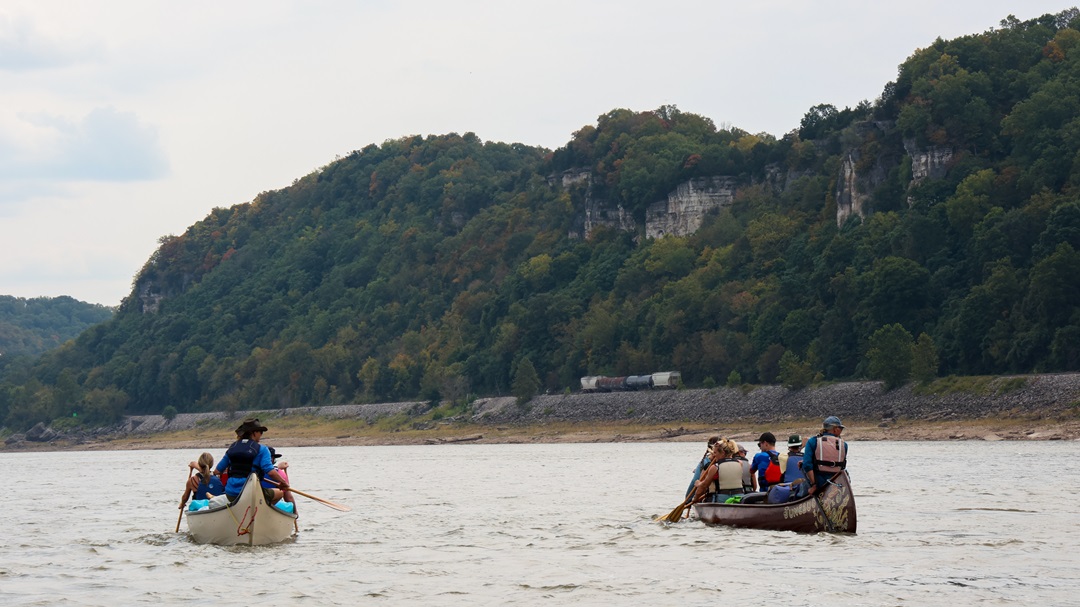
Big Muddy Adventures paddling on the Mississippi River. (Natalie Rolwes)
The planning for the trip, which BMA was calling the French Corridor Excursion, was laid back but with a purpose. The trip would travel a 55-mile path of the Mississippi that was important throughout time, especially for early settlement of the region. I discussed with Michael Clark, chief guide of BMA, the amount of food to take and the meals to be ready for. But the menu was to be all for me to decide, except Mike had two requests: pemmican and beaver tail.
These requests set the path for the food, just like the launch site and the destination curated our journey. Of course, the food had to do all of that while not being a stuffy history lesson from a stodgy professor. Luckily, that’s how BMA started — Mike led a virtual classroom the length of the river in the fall of 2001, teaching kids while they learned life skills maneuvering canoes on the Mighty Mississippi.
Day 1 of the trip was Friday in late September. The weather was beautiful, and the travelers all gathered at the BMA warehouse in downtown St. Louis. For any cooking gig and trip of this magnitude, it is a given that something will be forgotten. It’s only a matter of time before the misplaced item is revealed. Most of my morning was spent packing my dry bag and cooler, going over my mis en place, and making sure I packed the tools I would need for the menus. The same was true for the BMA staff, who were busy gathering last-minute supplies and loading the shuttle with life jackets, paddles, and gallons of water.
By 11 a.m., the expedition was in the shadow of the Arch, knee-deep in water. The boat was loaded with everyone’s personal belongings, food, water, and tents. As we paddled out into the Mississippi, the task in front of us became apparent: get through the Port of St. Louis as quickly as possible. With no headwind, we could easily maneuver around the tugboat traffic — Mike captained the boat with a great knowledge of the water and clear communication with upcoming towboats.
The leg of the trip in the Port of St. Louis plays havoc from a mental perspective. Each traveler knows the area that we are passing, but from the street level. I know what the Anheuser Busch buildings look like, but I had no idea that it is buttressed by a sea wall of its riverside. At the south end of Broadway, a pair of fiberglass legs shoot out of a pool overlooking the river; the Jefferson Barracks where the Air Force began is visible from the river, but not the cemetery. Finally, after two hours, we reached the end of the port with less traffic. We pulled the canoe over to the Illinois side of the river across from a quarry.
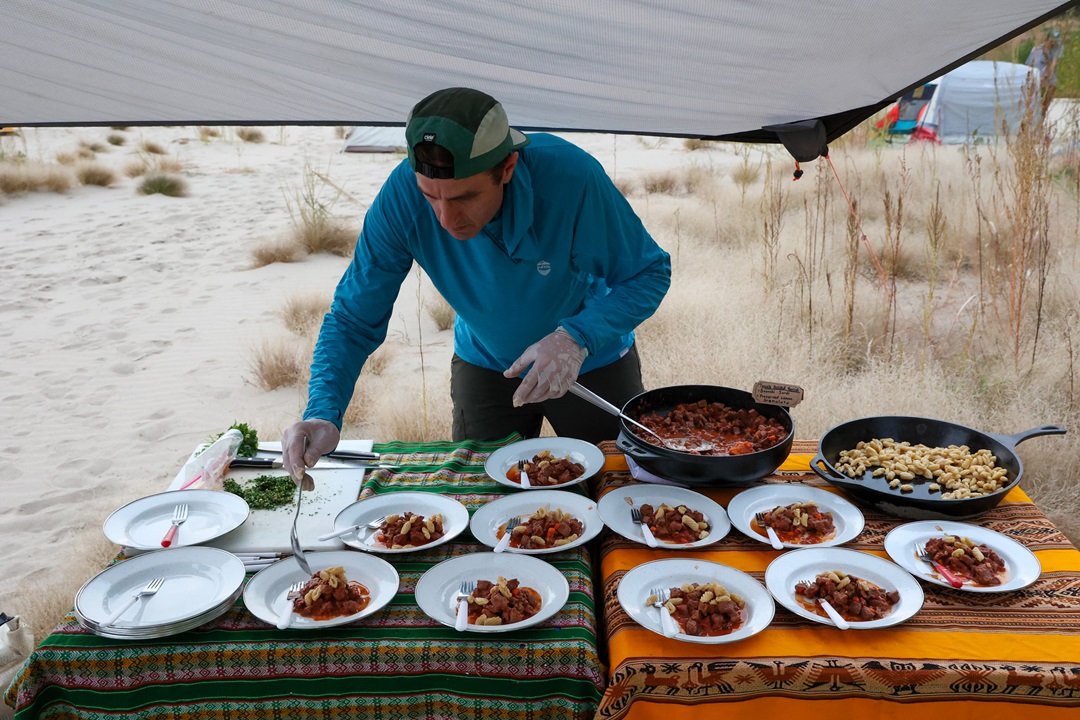
Chef Galliano preparing a meal on the French Corridor Excursion. (Natalie Rolwes)
The first bite of food on the trek’s menu had to be quick, filling, and unique. We didn’t have time to stop and cook a full meal. Chips and a sandwich always put people in a good mood, so I served a little New Orleans meets St. Louis with mini muffulettas and Red Hot Riplets. The sandwiches were made earlier that morning, so the oil from the olive salad could soak into the bread. There was no need to hammer home a story of how the river connects St. Louis and New Orleans, or the French connection, or the musical ties, or anything. We just needed some calories to keep us going after the muscle shock of getting used to paddling.
Our boat continued downriver. Less barge traffic was on the water. Still, Mike regaled us with stories of the history of the areas we passed, explained the meaning of towboat whistles, and told how the river worked all while giving a few pointers on paddling. After two more hours of rivertime, Mike was on the lookout for a campsite. We needed three things: easy access, driftwood to fuel the fire, and a good area for tents. We found a spot close to Kimmswick that fit perfectly.
Once the boat was unloaded, some travelers started on their tents. Mike arranged the “kitchen,” gathered firewood, and started a fire. I went to work on dinner. The first night told the story of the food and resources of Native Americans in an unabashedly reductionist analysis. There is no way to encapsulate all of the different tribes with all of the different cuisines and ingredients into one dish. Let’s just say the dinner was inspired by the foods of Native Americans. Venison shank was braised with fennel seed, lemon zest, and Calabrian chile and then served over a Three Sisters vegetable stew (sweet corn, butternut squash, and lima beans). Completely breaking out of the theme, the dish was finished with a herby salsa verde and a wedge of cornbread.
As dinner finished, Mike built the fire from a cooking fire to a gathering fire. The wind steadily blew, everyone layering up a little more, and a warm apple cider and Stil360 rum toddy was made. As I retired to my tent, I was greeted by a baby skunk who scurried off before anything disastrous could happen.
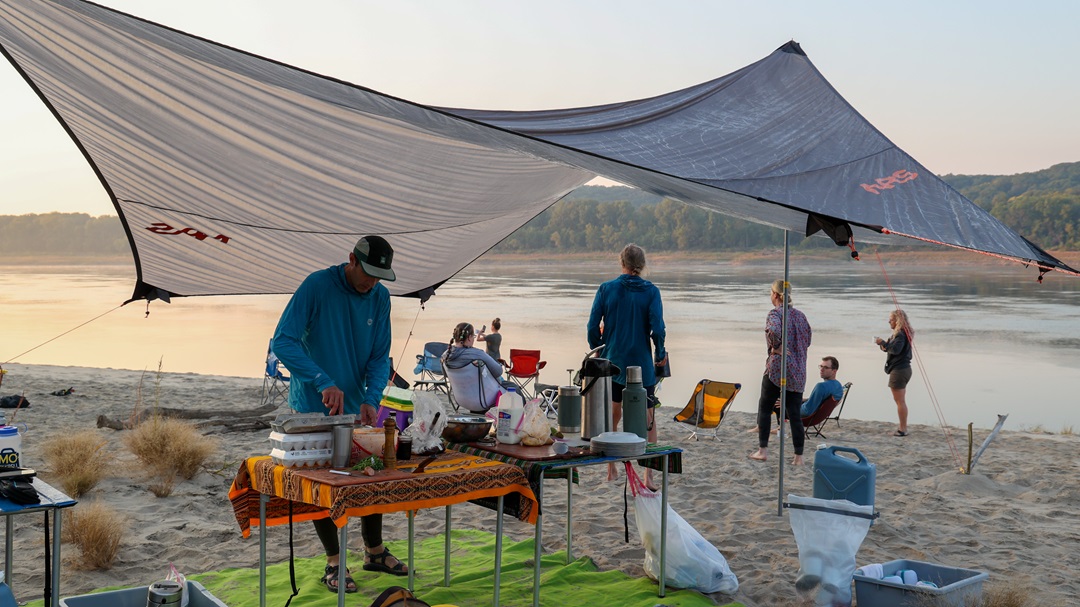
Food prep on the banks of the Mississippi River. (Natalie Rolwes)
Morning broke with some fog and a steady wind. The rest of the voyageurs were a little sluggish and barely stirring. Breakfast needed to be made to give our paddlers energy for the longer day ahead. A simple pancake recipe was modified with pawpaw pulp that was collected from the woods. After packing up, most of the fog burned off and our group could set off down the river again.
Saturday’s journey was roughly double the length of the previous day. The strong headwind out of the south slowed down the paddling progress. Homemade energy bites and granola bars helped to keep spirits high. On a sandbar south of a coal-fired power plant, we parked the canoe to make a quick lunch.
During many sections of Lewis and Clark’s historic expedition, hunted meat was abundant. But at other times, meat was scarce. Our lunch was an ode to those leaner tines and to a meal that brought joy to The Corps of Discovery back in 1805. A simple game broth was seasoned with sweet spices and garnished with ribbons of zucchini. Beef suet dumplings were floated in the broth; think of the dumplings as biscuit dough made with beef fat instead of butter.
Saturday’s goal was simple: Fort Chartres Island. This sometimes island is the original site for the Fort De Chartres that has been moved and rebuilt as the river has changed its course and mind. The current Fort is in Prairie du Rocher, about a mile from the island. Getting to the Fort proved more difficult than expected due to a strong headwind that slowed us down. Also, the island was not surrounded by the Mississippi. The water level was low, creating more of a bog surrounding the island than a river. As the water receded, driftwood piled up, poison ivy grew, and the displaced river buoys rammed into trees, creating barricades. In short: I got lost trying to hike to the Fort.
Dinner on Fort Chartres Island was a homage to the Illinois frontier. Mike had asked for beaver tail, and before disgust sets in, hear me out. Beaver tail was a luxury in the days of Lewis and Clark. It was high in calories and fairly abundant. Yet, it has fallen out of favor and is not easy to buy. To mimic beaver tail, Saturday’s dinner was roasted pork jowls, since it has a similar ratio of meat and fat. As the Fort was the gateway to colonial Illinois, the jowl was accompanied by Illinois-grown items like long-grain rice from Cahokia and wild chanterelles. With the second day of the journey done, everyone relaxed a little more by the campfire, with some of the voyageurs entertaining the group with fire art.
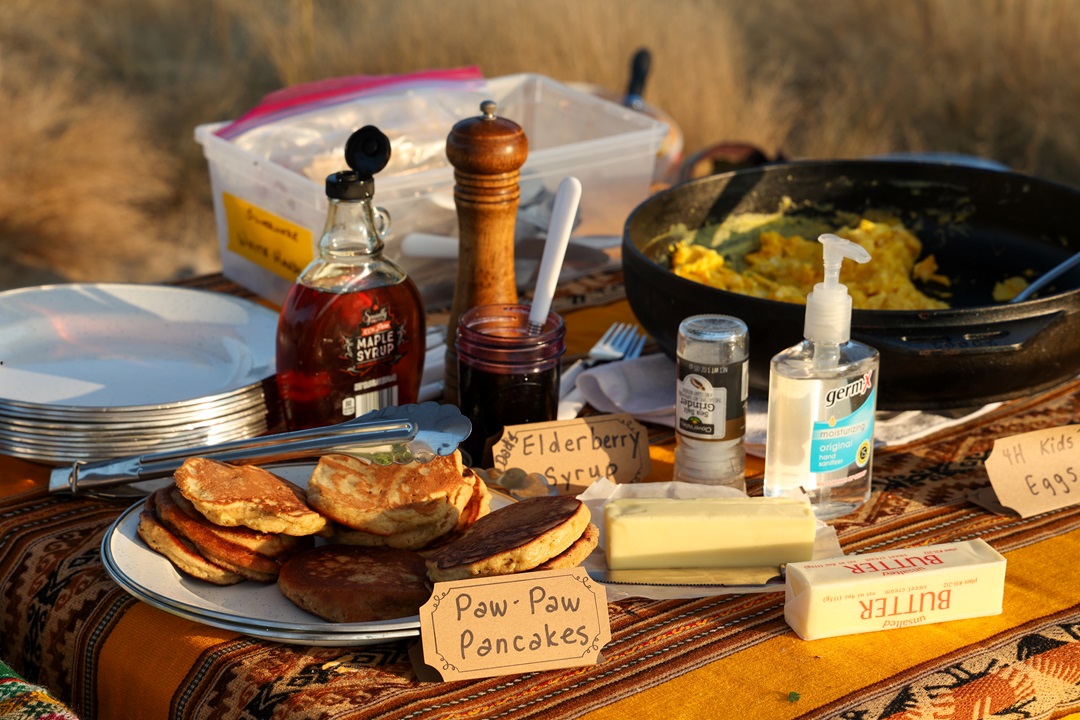
Breakfast spread on the French Corridor Excursion. (Natalie Rolwes)
The final day began by feeling final. There were no more monuments to pass, no break to look forward to, but instead, there was just the finish point in Ste. Genevieve. Asian carp flitted around the small inlet as we packed the canoe. Once on the river, the sun slowly lifted overhead and the wind was just enough to keep us cool. As we pushed on for the last stretch of the adventure, we marveled at eagles chasing vultures and we dodged the occasional tugboat. The final bit of sustenance was pemmican, a mixture of cooked ground meat mixed with honey, dried fruits, sorghum molasses, and just enough melted fat to hold it all together. It’s loaded with protein, fat, and sugar that provided a great source of nutrition to Native Americans.
The meals for the French Corridor journey were not faithful recreations of historical accounts. We did not try to bring portable soup, barrels of lard, salted meat, or the copious amounts of whiskey that Lewis recorded in his journals. We told stories about the food of a long-ago time, of a place in Middle America, and of the greatest waterway of our country. Plus, a story is only as good as it tastes.
Author: Josh Galliano is a St. Louis-based chef who studied at Le Cordon Bleu and worked with Daniel Boulud.
Photos: Chef Josh Galliano on the French Corridor Excursion. (Natalie Rolwes)

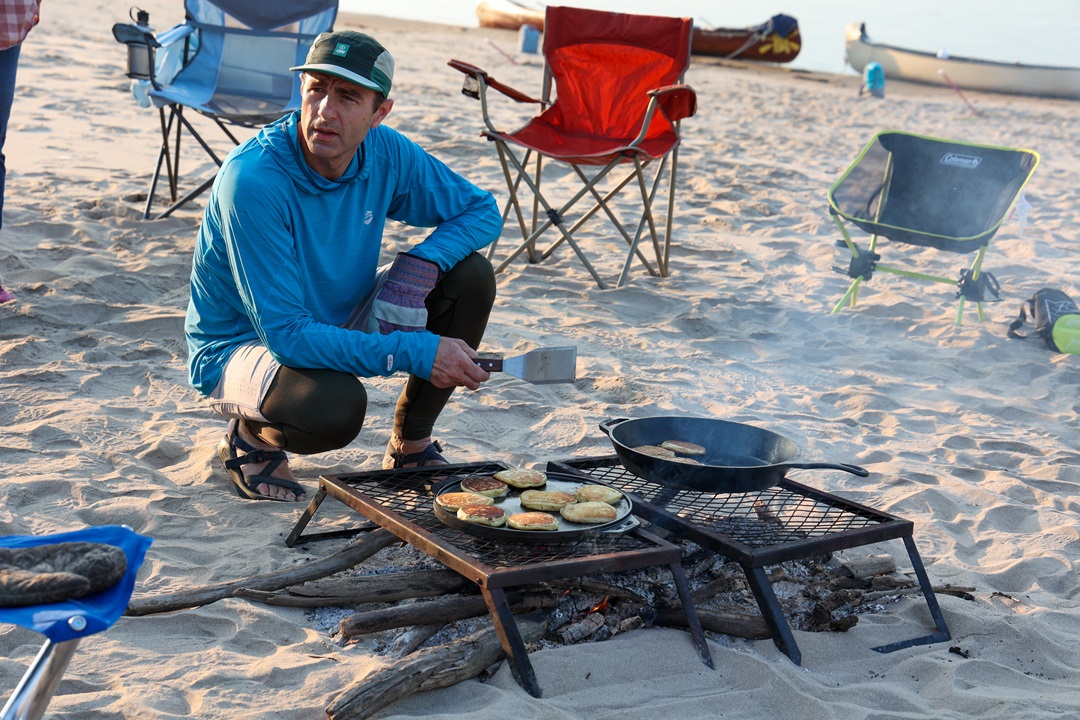
Leave A Comment